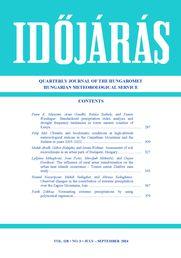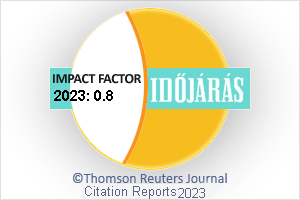IDŐJÁRÁS - angol nyelvű folyóirat
Vol. 128, No. 3 * Pages 287–398 * July - September 2024
 |
|
 letöltés [pdf: 3509 KB]
letöltés [pdf: 3509 KB]
Standardized precipitation index analysis and drought frequency tendencies in lower eastern counties of Kenya
Peter K. Musyimi, Balázs Székely, Arun Gandhi, and Tamás Weidinger
DOI:10.28974/idojaras.2024.3.1 (pp. 287–308)
Peter K. Musyimi, Balázs Székely, Arun Gandhi, and Tamás Weidinger
DOI:10.28974/idojaras.2024.3.1 (pp. 287–308)
Climatic and bioclimatic conditions at high-altitude meteorological stations in the Carpathian Mountains and the Sudetes in years 2005–2022
Filip Miś
DOI:10.28974/idojaras.2024.3.2 (pp. 309–325)
Filip Miś
DOI:10.28974/idojaras.2024.3.2 (pp. 309–325)
Assessment of soil microclimate in an urban park of Budapest, Hungary
Malek Abidli, Gábor Halupka, and István Waltner
DOI:10.28974/idojaras.2024.3.3 (pp. 327–344)
Malek Abidli, Gábor Halupka, and István Waltner
DOI:10.28974/idojaras.2024.3.3 (pp. 327–344)
The influence of rural areas transformation on the urban heat islands occurrence – Тourist center Zlatibor case study
Ljiljana Mihajlović, Ivan Potić, Miroljub Milinĉić, and Dejan Đorđević
DOI:10.28974/idojaras.2024.3.4 (pp. 345–366)
Ljiljana Mihajlović, Ivan Potić, Miroljub Milinĉić, and Dejan Đorđević
DOI:10.28974/idojaras.2024.3.4 (pp. 345–366)
Observed changes in the contribution of extreme precipitation over the Zagros Mountains, Iran
Hamid Nazaripour, Mehdi Sedaghat, and Alireza Sadeghinia
DOI:10.28974/idojaras.2024.3.5 (pp. 367–377)
Hamid Nazaripour, Mehdi Sedaghat, and Alireza Sadeghinia
DOI:10.28974/idojaras.2024.3.5 (pp. 367–377)
Forecasting extreme precipitations by using polynomial regression
Fatih Dikbaş
DOI:10.28974/idojaras.2024.3.6 (pp. 379–398)
Fatih Dikbaş
DOI:10.28974/idojaras.2024.3.6 (pp. 379–398)
IDŐJÁRÁS folyóirat

Az IDŐJÁRÁS a HungaroMet Nonprofit Zrt. negyedévenként megjelenő angol nyelvű folyóirata
Megrendelhető a journal.idojaras@met.hu címen.
A szerzőknek szánt útmutató itt olvasható.
Megrendelhető a journal.idojaras@met.hu címen.
A szerzőknek szánt útmutató itt olvasható.









